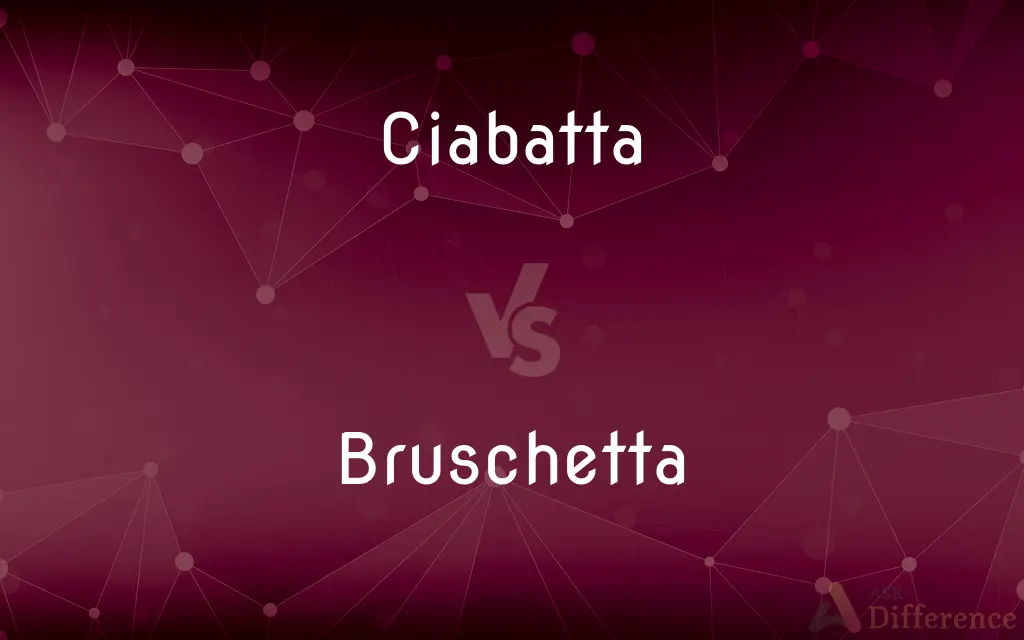Ciabatta vs. Bruschetta — What's the Difference?
Edited by Tayyaba Rehman — By Maham Liaqat — Updated on April 15, 2024
Ciabatta is a soft, chewy Italian bread with a distinct crust, ideal for sandwiches, while bruschetta refers to toasted bread topped with ingredients like tomatoes and basil.

Difference Between Ciabatta and Bruschetta
Table of Contents
ADVERTISEMENT
Key Differences
Ciabatta, originating from Italy, is known for its soft, porous texture and chewy interior, making it perfect for absorbing dressings and sauces in sandwiches. Bruschetta, while also Italian, is not a type of bread but a dish consisting of grilled bread topped with various mixtures, most famously chopped tomatoes and basil.
The dough of ciabatta includes wheat flour, water, salt, and yeast, often with olive oil, creating a moist loaf with a crispy crust. Bruschetta uses simpler bread as a base, typically toasted to achieve a crispy texture which contrasts with its moist toppings.
Ciabatta is typically large and somewhat flat, suited for slicing horizontally; it serves as a staple in many Italian sandwiches, such as panini. Bruschetta is usually made from smaller slices of bread like baguette, which are grilled or toasted and then topped with a variety of fresh ingredients.
When served, ciabatta is often seen in sandwich shops and Italian cuisine as a versatile bread option that complements a variety of ingredients. Bruschetta is typically offered as an appetizer, showcasing the freshness of its toppings, like ripe tomatoes, fresh basil, and a drizzle of olive oil.
The preparation of ciabatta requires careful handling to maintain its light, airy texture, with a slow fermentation process that enhances its flavor. In contrast, bruschetta preparation focuses on the toppings; the bread is simply grilled or toasted to provide a crisp base.
ADVERTISEMENT
Comparison Chart
Type
Bread
Dish
Origin
Italy
Italy
Primary Use
Sandwiches
Appetizer
Texture
Soft, chewy interior with a crispy crust
Depends on the bread used, generally toasted
Key Ingredients
Wheat flour, water, salt, yeast, sometimes olive oil
Bread (e.g., baguette), toppings like tomatoes
Compare with Definitions
Ciabatta
Known for its elongated, broad, and flat shape.
The baker shaped the dough into the classic ciabatta form.
Bruschetta
An Italian appetizer consisting of grilled bread topped with various ingredients.
For a starter, they served a tomato and basil bruschetta.
Ciabatta
Features a crisp crust and soft, porous interior.
The ciabatta's crust crunched satisfyingly under pressure.
Bruschetta
Traditionally topped with a mixture of chopped tomatoes, basil, and garlic.
He seasoned the bruschetta topping with fresh basil.
Ciabatta
A type of Italian white bread made from wheat flour, water, salt, yeast, and olive oil.
She sliced the ciabatta in half to make a hearty sandwich.
Bruschetta
The bread is typically toasted to offer a crisp contrast to the toppings.
She toasted the slices lightly before adding the toppings.
Ciabatta
Often used in sandwiches and paninis due to its absorbent texture.
They chose ciabatta for the panini for its ability to soak up the olive oil and vinegar.
Bruschetta
Can be varied with toppings like mushrooms, beans, or cheese.
They offered a mushroom bruschetta alongside the classic version.
Ciabatta
Requires a longer fermentation to develop its flavor and texture.
The dough for the ciabatta was left to ferment overnight.
Bruschetta
Served usually as a pre-meal snack or casual finger food.
The guests mingled over plates of bruschetta at the party.
Ciabatta
Ciabatta (, Italian: [tʃaˈbatta]; literally "slipper") is an Italian white bread made from wheat flour, water, salt, yeast and olive oil, created in 1982 by a baker in Adria, province of Rovigo, Veneto, Italy, in response to the popularity of French baguettes. Ciabatta is somewhat elongated, broad, and flat, and is baked in many variations, although unique for its alveolar holes.
Bruschetta
Bruschetta (, , Italian pronunciation: [bruˈsketta] (listen)) is an antipasto (starter dish) from Italy consisting of grilled bread rubbed with garlic and topped with olive oil and salt. Variations may include toppings of tomato, vegetables, beans, cured meat, or cheese.
Ciabatta
A porous bread with a crispy crust, baked in a flattish, usually oblong loaf.
Bruschetta
Slices of bread that have been broiled, rubbed with garlic, brushed with olive oil, seasoned with salt, and layered with any of various toppings such as chopped tomatoes, mozzarella cheese, or ham.
Ciabatta
A broad, flat, white Italian bread.
Bruschetta
A light Italian dish of toasted bread with a topping of olive oil, garlic and chopped tomatoes.
Common Curiosities
Can ciabatta be used for making bruschetta?
Yes, ciabatta can be used for making bruschetta, providing a chewy, absorbent base for various toppings.
What are typical toppings for bruschetta?
Typical toppings include chopped tomatoes, basil, garlic, and olive oil, but variations might include mushrooms, cured meats, or cheeses.
What distinguishes bruschetta from other appetizers?
Bruschetta is distinguished by its combination of toasted bread and fresh, vibrant toppings, typically featuring tomatoes and basil.
How is ciabatta's texture different from other breads?
Ciabatta's texture is notably soft and porous with a crisp crust, ideal for absorbing liquids without becoming soggy.
What is ciabatta bread commonly used for?
Ciabatta is commonly used for making sandwiches and paninis due to its absorbent and durable texture.
What is the best way to toast bread for bruschetta?
The best way to toast bread for bruschetta is to grill or broil it until it's golden and crisp, which enhances its flavor and texture.
Are there gluten-free versions of ciabatta?
Yes, there are gluten-free versions of ciabatta available that substitute traditional wheat flour with gluten-free alternatives.
What are creative variations of bruschetta?
Creative variations of bruschetta might include toppings like avocado and shrimp, or pesto and mozzarella.
What is the origin of ciabatta bread?
Ciabatta bread originated in Italy as a response to the popularity of French baguettes.
How long does it take to prepare ciabatta?
Preparing ciabatta usually takes several hours, as the dough needs to ferment to develop its unique texture and flavor.
Can ciabatta be frozen for later use?
Yes, ciabatta can be frozen and is best when thoroughly thawed and reheated to restore its texture.
Is bruschetta considered a healthy option?
Bruschetta can be a healthy option, especially when topped with fresh, simple ingredients like tomatoes and basil.
How should ciabatta dough be handled during preparation?
Ciabatta dough should be handled gently to avoid deflating the air pockets that contribute to its characteristic texture.
What makes bruschetta a popular choice at Italian restaurants?
Bruschetta is popular for its simplicity, fresh flavors, and as a light, appetizing start to a meal.
How do you keep bruschetta from becoming soggy?
To prevent bruschetta from becoming soggy, toast the bread thoroughly and add the toppings just before serving.
Share Your Discovery

Previous Comparison
Personification vs. Hyperbole
Next Comparison
Feta vs. TofuAuthor Spotlight
Written by
Maham LiaqatEdited by
Tayyaba RehmanTayyaba Rehman is a distinguished writer, currently serving as a primary contributor to askdifference.com. As a researcher in semantics and etymology, Tayyaba's passion for the complexity of languages and their distinctions has found a perfect home on the platform. Tayyaba delves into the intricacies of language, distinguishing between commonly confused words and phrases, thereby providing clarity for readers worldwide.














































